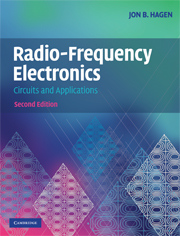Book contents
- Frontmatter
- Contents
- Preface
- 1 Introduction
- 2 Impedance matching
- 3 Linear power amplifiers
- 4 Basic filters
- 5 Frequency converters
- 6 Amplitude and frequency modulation
- 7 Radio receivers
- 8 Suppressed-carrier AM and quadrature AM (QAM)
- 9 Class-C, D, and E Power RF amplifiers
- 10 Transmission lines
- 11 Oscillators
- 12 Phase lock loops and synthesizers
- 13 Coupled-resonator bandpass filters
- 14 Transformers and baluns
- 15 Hybrid couplers
- 16 Waveguide circuits
- 17 Small-signal RF amplifiers
- 18 Demodulators and detectors
- 19 Television systems
- 20 Antennas and radio wave propagation
- 21 Radar
- 22 Digital modulation techniques
- 23 Modulation, noise, and information
- 24 Amplifier and oscillator noise analysis
- 25 The GPS Navigation system
- 26 Radio and radar astronomy
- 27 Radio spectrometry
- 28 S-parameter circuit analysis
- 29 Power supplies
- 30 RF test equipment
- Index
- References
16 - Waveguide circuits
Published online by Cambridge University Press: 05 June 2012
- Frontmatter
- Contents
- Preface
- 1 Introduction
- 2 Impedance matching
- 3 Linear power amplifiers
- 4 Basic filters
- 5 Frequency converters
- 6 Amplitude and frequency modulation
- 7 Radio receivers
- 8 Suppressed-carrier AM and quadrature AM (QAM)
- 9 Class-C, D, and E Power RF amplifiers
- 10 Transmission lines
- 11 Oscillators
- 12 Phase lock loops and synthesizers
- 13 Coupled-resonator bandpass filters
- 14 Transformers and baluns
- 15 Hybrid couplers
- 16 Waveguide circuits
- 17 Small-signal RF amplifiers
- 18 Demodulators and detectors
- 19 Television systems
- 20 Antennas and radio wave propagation
- 21 Radar
- 22 Digital modulation techniques
- 23 Modulation, noise, and information
- 24 Amplifier and oscillator noise analysis
- 25 The GPS Navigation system
- 26 Radio and radar astronomy
- 27 Radio spectrometry
- 28 S-parameter circuit analysis
- 29 Power supplies
- 30 RF test equipment
- Index
- References
Summary
In this chapter we examine rectangular metal waveguides and, in particular, their most common mode of operation, the fundamental “TE10” mode. We will also see how the concepts developed for two-conductor transmission lines apply to waveguides and look at waveguide versions of some low-frequency components.
The ability of a hollow metal pipe to transmit electromagnetic waves can be demonstrated by holding it in front of your eye. You can see through it, so, at least, it passes electromagnetic waves of extremely short wavelengths. From a purely dimensional analysis, you would guess correctly that the longest wavelength a pipe could transmit must be of the order of the pipe's transverse dimensions. It turns out that, for propagation in a rectangular pipe, the free-space wavelength, c/f, must be less than twice the longer transverse dimension and, for a circular pipe, less than 1.706 times the diameter. Waveguides have less loss and more power handling capacity than coaxial lines of the same size and they need no center conductor nor insulating structures to support a center conductor. Metal waveguides are used most often in the range from 1000 MHz to 100 GHz, where they have practical dimensions. Waveguides for optical frequencies are coated glass fibers.
Simple picture of waveguide propagation
A common RF engineering argument for the plausibility of transmitting electromagnetic waves through a hollow metal pipe is shown in Figure 16.1, where a two-conductor transmission line evolves into a waveguide. Quarter-wave shorted stubs are added to the line.
- Type
- Chapter
- Information
- Radio-Frequency ElectronicsCircuits and Applications, pp. 195 - 207Publisher: Cambridge University PressPrint publication year: 2009



